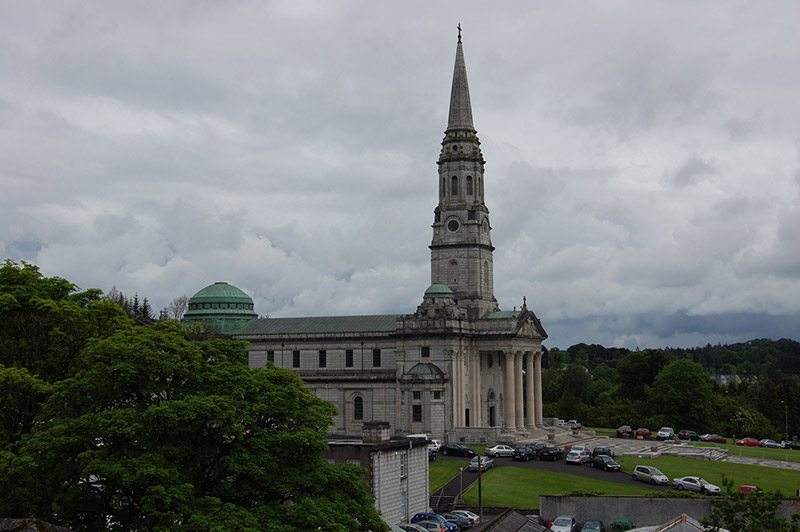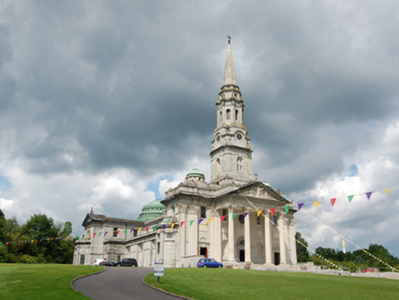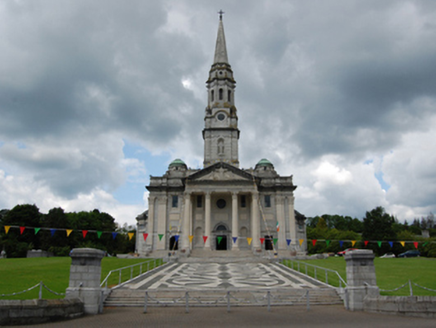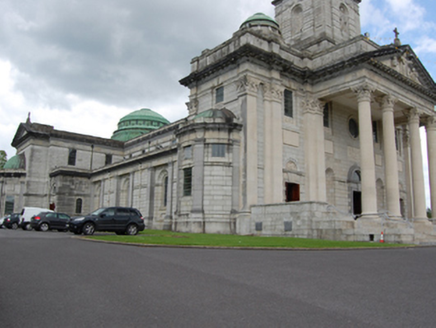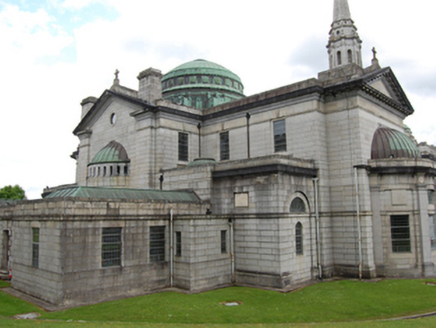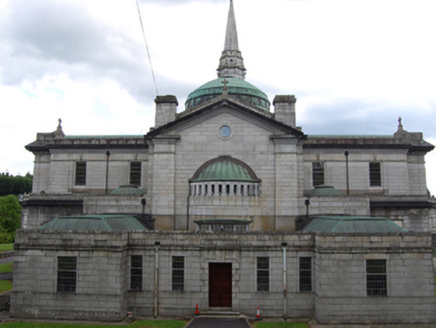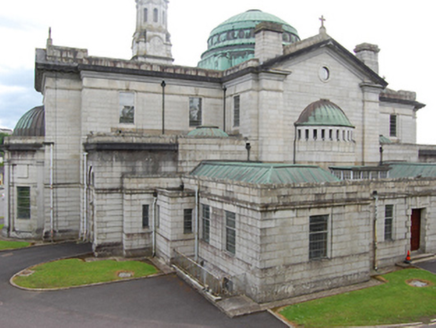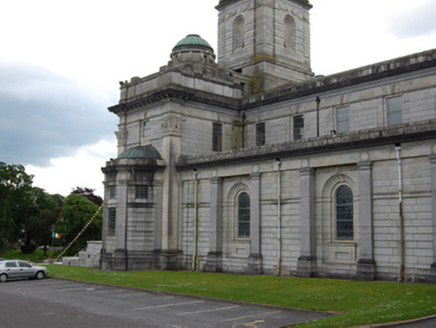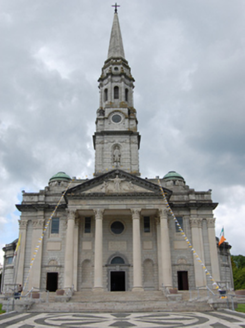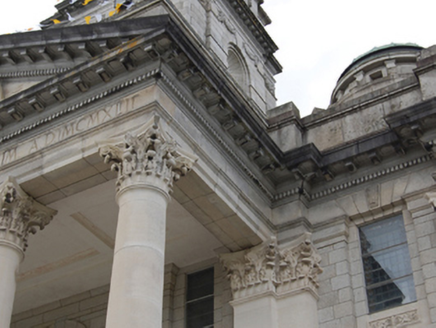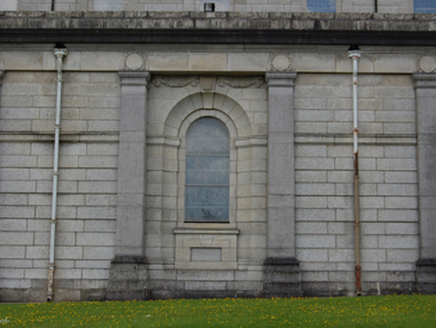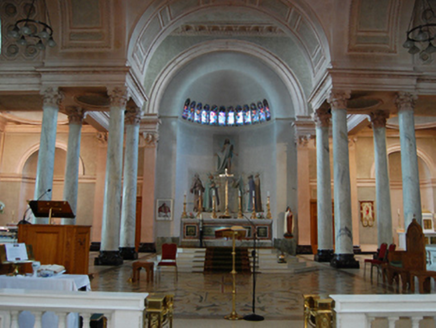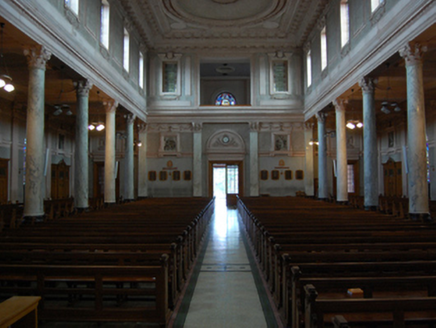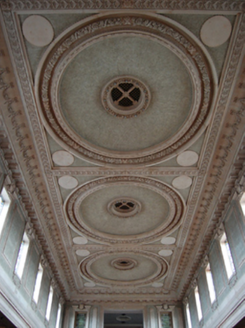Survey Data
Reg No
40000113
Rating
Regional
Categories of Special Interest
Architectural, Artistic, Historical, Social
Original Use
Cathedral
In Use As
Cathedral
Date
1935 - 1945
Coordinates
241891, 305267
Date Recorded
14/06/2012
Date Updated
--/--/--
Description
Freestanding Latin-cross plan five-bay double-height cathedral in monumental neo-Classical style, built 1939-1942, with Corinthian prostyle tetrastyle pedimented portico, four-stage tower and octagonal spire flanked by cupolas. Seven-bay nave with single-storey aisles, two bay transepts with single-storey side chapels and dome over crossing, apses with half cupolas to ends of transepts and narthex, advanced side entrances to side aisles adjoining transepts, seven-bay single-storey sacristy wing to west having recessed central bay with lantern rooflight. Square-plan four-stage tower of Wicklow granite ashlar and Portland stone, rusticated at first stage with niches in breakfront to each face having statue of Blessed Virgin Mary to front, oculi with margents to each face at second stage with corners surmounted by urns, octagonal-plan third stage with louvred round-arched belfry openings to each face with festoon decoration and engaged Corinthian columns to corners supporting entablature, fourth stage as attic storey with oculi between scrolled buttresses surmounted by spire with bronze cross. Pitched copper roofs behind parapet blocking course, flat roofs to aisles and side chapels. Copper mansard roofs to outer bays of vestry with flat roof around copper-clad flat-roofed multiple-pane lantern light. Copper domes over crossing, side chapels, apses and flanking steeple. Cast-iron rainwater downpipes and hopper heads. Wicklow granite ashlar walls with Portland stone detailing. Five-bay front elevation with central pediment having cross to apex, modillion cornices, tympanum with high-relief sculptural group of Christ with SS Patrick and Felim to either side, frieze reading 'D.O.M. SUB INVOC. S. PATRIT. ET. S. FEDLIM. A.D. MCMXLII'. Portland stone Corinthian columns to portico, responding giant-order pilasters framing outer bays with paired end pilasters. Centrally positioned limestone doorcase composed of square-headed door with architrave, keystone and cornice with semi-circular fanlight in archivolt, central oculus at upper level, door flanked by apsoidal niches with square headed windows within recesses over, plaques between storeys, with coat-of arms to central plaque. Side elevations having frieze with paterae and margents over Doric pilasters flanking round-arched windows in alternate recessed bays having concave reveals, panelled aprons and floral festoons on either side of rock-faced keystone, moulded string course at impost. Square-headed openings with raised keystone to clerestory, square-headed door opening and semi-circular fanlight to side entrance porch. Pedimented transepts with pilasters and impost course taken around semi-circular apse. Single-storey sacristy to rear with parapet over cornice and central doorcase in blocked architrave with keystone. Interior in manner of Roman basilica with compartmented plasterwork ceiling of round panels, clerestory window in architraves over entablature on Corinthian columns of Pavonazzetto marble. Sanctuary extending into crossing with stucco coffered dome over, top-lit side chapels to either side of altar, separated from chancel and side aisles by Corinthian columns of Pavonazzetto marble with black marble pedestals. High altar of green Connemara and pink Middleton marble raised on plinth. Row of twelve stained-glass windows each representing an apostle to bowed apse behind altar over mural of the Risen Christ surrounded by native saints by George Collie (1904-1975). Stations of the Cross also by Collie, six stained-glass windows to nave, window in south transept from the studios of Harry Clarke. Main portico approached by wide granite steps in two flights with ironwork handrails in serpentine form. Square-plan granite piers and wide paved approach in geometric pattern divided by two flights of granite steps.
Appraisal
A monumental neo-Classical cathedral which, along with Galway Cathedral of 1965, is one of the last large-scale cathedrals to be built in Ireland. Designed by Ralph Byrne of W.H. Byrne & Son and built by John Sisk and Sons Ltd, it replaced an earlier church of 1823 that had been promoted to cathedral status c.1850 and was dismantled in 1942 and rebuilt in the parish of Castletara. The cathedral retains its original appearance and is distinguished by a spire rising from behind an impressive portico, a motif used by Francis Johnston and derived from James Gibbs's London church of St Martin-in-the-Fields. The ashlar stonework and sculpted tympanum display skilled craftsmanship and design and testify to the endurance of high quality of workmanship into the middle of the twentieth century. Fine interior features such as the stucco ceiling, statues, mural and the stained glass windows by George Collie and Harry Clarke studio are of high artistic value. The classical style of the cathedral reflects the conservatism of church architecture prior to the radical change after the Second Vatican Council, and the scale and ambition of the design demonstrate the prestige and confidence of the Catholic Church in that period. The cathedral is the part of an ecclesiastical group of buildings, also including the current and former presbyteries, which complement its setting and context, and form part of a wider ensemble of civic, ecclesiastical and residential buildings arranged along Farnham Street. The prominent elevated site and the spire rising above the town make the cathedral an important landmark and dominant feature on the skyline of Cavan town.
